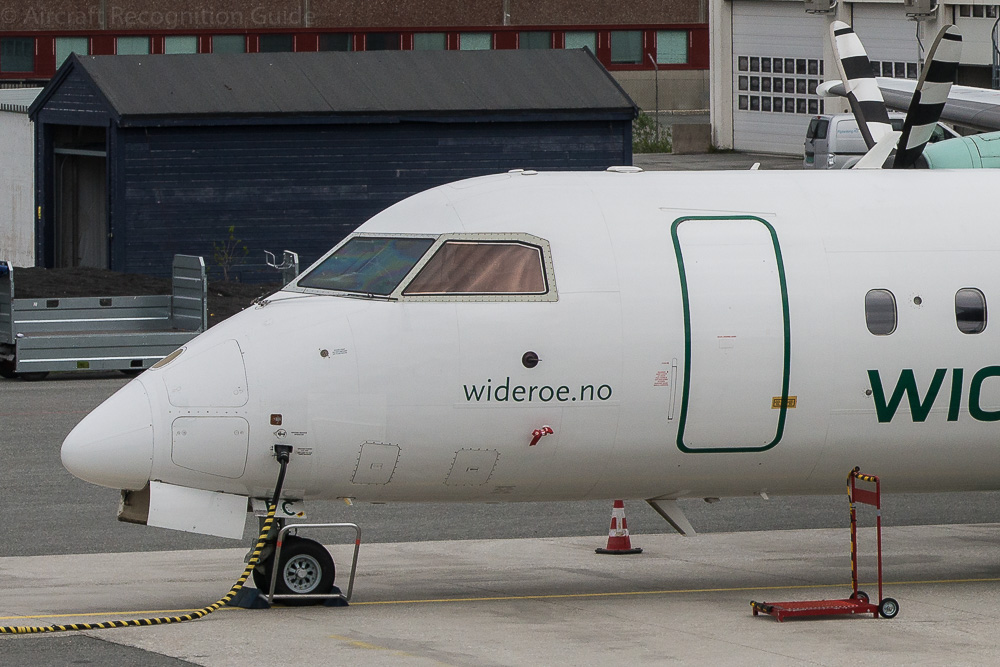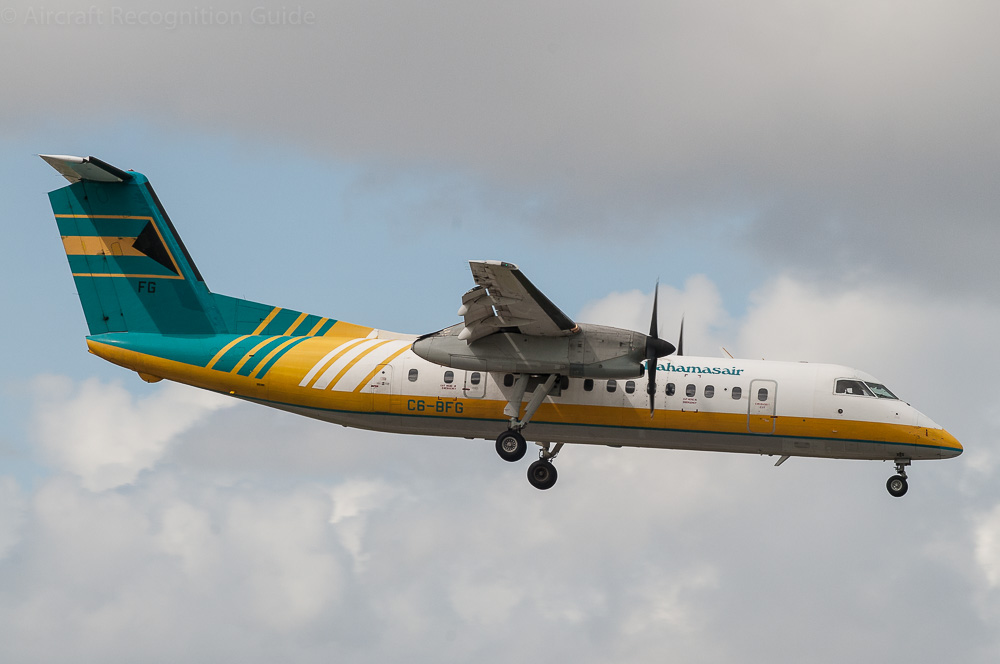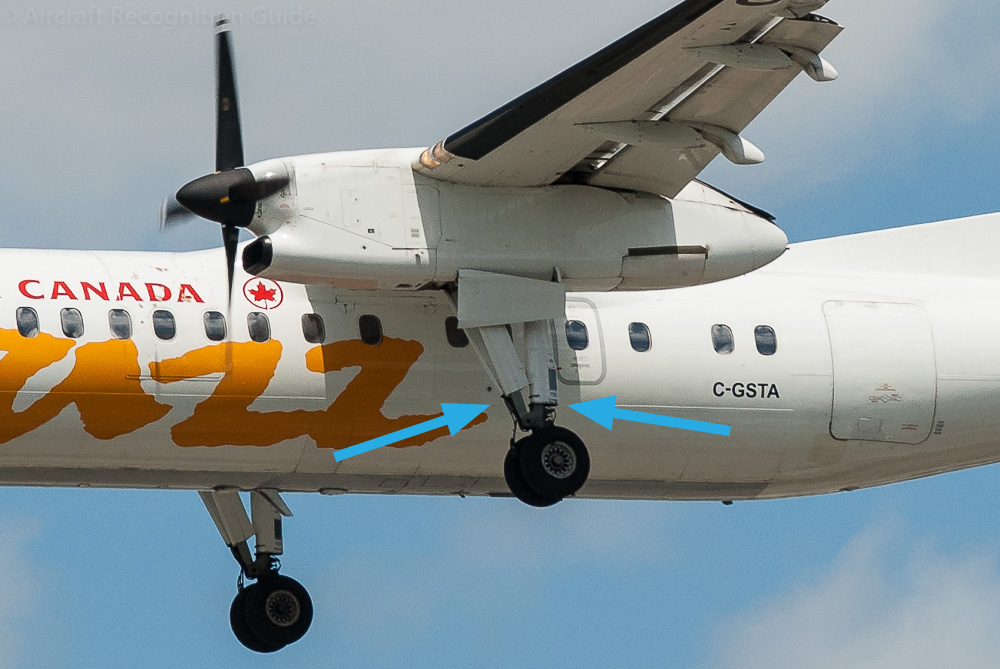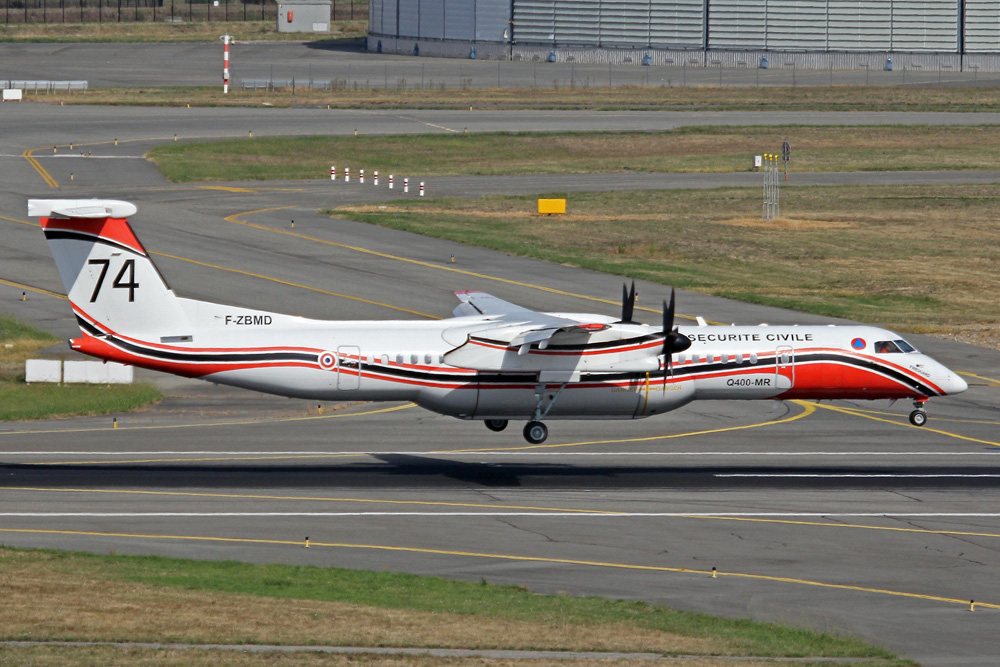
DeHavilland Canada (Bombardier) DHC-8
While DeHavilland Canada was already building the fifty seat Dash 7, this four engined turboprop aircraft was considered not suitable for the emerging commuter market in the early 1980s. Hence the Dash 7 was transformed into the twin Dash 8. The basic configuration - with high mounted wings, a T-tail and long main landing gear legs retracting in the engine nacelles - was retained. The cockpit windows are different though and look much like those on the Canadair Challenger, Canadair Regional Jets and Bombardier Global series. All-in all based on these points the aircraft is quite easy to recognise.
The Dash 8 series has four main versions, differing in size from about 35 to up to 90 passengers.
Different versions
The different versions of the Dash Eight family can be distinguished by:
- the length of the fuselage
- the shape of the engine nacelles
- the shape of the vertical stabiliser
- the presence of strakes behind the wings
DHC-8 Series 100 & DHC-8 Series 200
The first production version was the Series 100, which is also the shortest of all variants. It has small emergency exits in between the main landing gear and the props. There are several subversions of the Series 100, all differening in exact engine type and maximum take-off weight. These are DHC-8-101, -102, -102A, -103 and -106.
The Canadian air force has used two versions of the Series 100, designated CC-142 and CT-142. The first was a pure transport aircraft, while the other was a navigation trainer.
E-9A is the US military designation of two Dash 8s used for surveillance in support of military exercises over the Gulf of Mexico.
Voyageur Aviation offers a conversion programme for the Series 100 aircraft to package freighter, called DHC-8-100PF. In this version the cabin windows have been replaced by metal plugs.
Series 200 has the fuselage length of the Series 100, but the more powerfull engines of the Series 300. From the outside this is not visible though. It comes in the subversions DHC-8-201 and -202. When these aircraft are fitted with an active noise suppression system, they are marketed as Q200.
The Canadian forces used the short body Dash Eights designated as CC-142 and CT-142. The latter is shown here.
DHC-8 Series 300
The Dash 8 Series 300 is nearly 3.5 metres longer than the Series 100/200. For most people this is enough to identify this version, but when in doubt, look for the location of the emergency exits. On the Series 300 these are behind the wings. There are several subversions that mainly differ in exact engine version, namely DHC-8-301, 311, -314 and -315. The DHC-8-301 has a different main landing gear though than the other subtypes. The later models have a slightly tilted backward landing gear and hence different streamline bodies around the gear. When Series 300 aircraft have been equipped with an active noise and vibration suppression system, they are marketed as Q300.
This version is also used by the US military. RO-6A is the designation for a US Army electronic observation platform based on the DHC-8-315, the successor of the RO-5 based on the Dash 7. The US Army parachuting team "Golden Knights" uses two DHC-8-315s which are know as C-147A.
Main landing gear of DHC-8-301, with a short streamline body on the diagonal leg and straight body on aft leg.
DHC-8 Series 400
The longest and most popular series of the Dash Eight is the Series 400, often referred to as just Q400 when they have a noise reduction system. The Series 400 are nearly seven metres longer than the Series 300. The engines have six bladed props instead on four on the other versions. Along the bottom of the fuselage, aft of the wings, are strakes giding the air flow. Finally, on the top of the vertical stabiliser is a small bullet fairing. The main subtypes of the Series 400 are the DHC-8-400, -401 and -402, having a different number of seats.
Special variants have drop tanks in the fuselage, resulting in a much wider fuselage below the wings. They are named DHC-8-400MR by the Sécurité Civile in France ad DHC-8-400AT by Conair of Canada. In both cases they used for fire fighting.
Another version is the DHC-8-402PF package freighter, which had its cabin windows replaced by metal plugs.
Colgan Air and Republic Airlines operated a fleet of Dash 8 Series 400 aircraft for United Express. These were designated as Q400 NextGen, with several updates not noticable from the outside.
Several Series 400 have been converted to aerial fire fighters. These have a big bulge around the fuselage, below the wings. Here is a DHC-8-402MR of the Sécurité Civile. (photo Ken Fielding/WikiMedia)
Confusion possible with
Dornier 328-100
The aircraft that looks most like the shortest Dash 8, the Series 100, is the Dornier 328-100. It has similar configuration and cockpit windows, but a short landing gear retracting in the fuselage and oval cabin windows. Also note the streamline body on top of the fuselage.
Aérospatiale/Alenia ATR42/72
While being of the same size and basic configuration as the Dash 8 series the ATR42 and ATR72 can be easily recognised by the short main landing gear that retracts in fuselage pods. Also the cockpit has six windows.
DeHavilland Canada DHC-7
Although the Dash 8 has two engines and the Dash 7 four, they still have a lot in common, in particular behind the wings. For the rest the Dash 8 has a different nose with cockpit windows and a main landing gear that retracts rearward in the nacelles.
IPTN N250

The N250 looks most like an ATR42 than a Dash 8. It also has a short landing gear attached to the fuselage and six cockpit windows, and additionally has oval cabin windows. The tail is more similar to that of the DHC-8 though. (photo WikiMedia/Eka viation)
DeHavilland Canada DHC-5
It is from the same company with the same basic configuration, but the Buffalo is still significantly different. It has more cockpit windows, oval cabin windows, a forward retracting main landing gear and a rear loading ramp.















